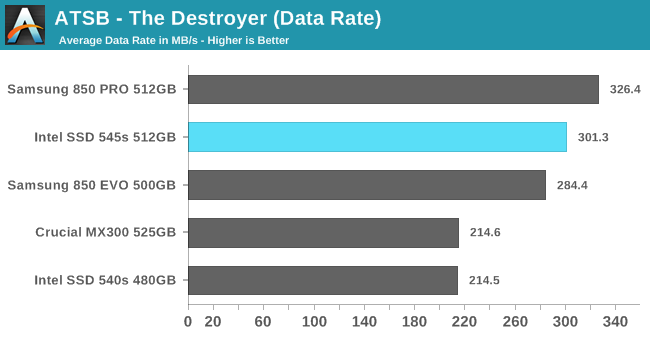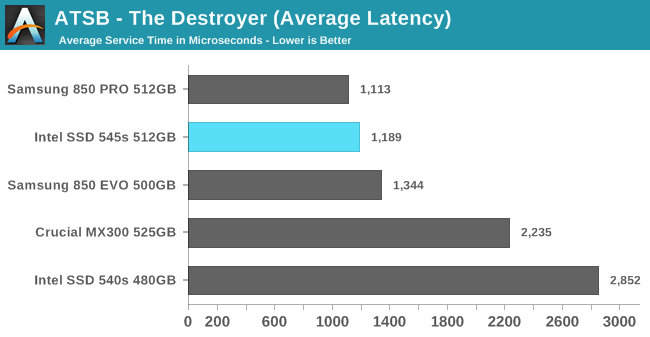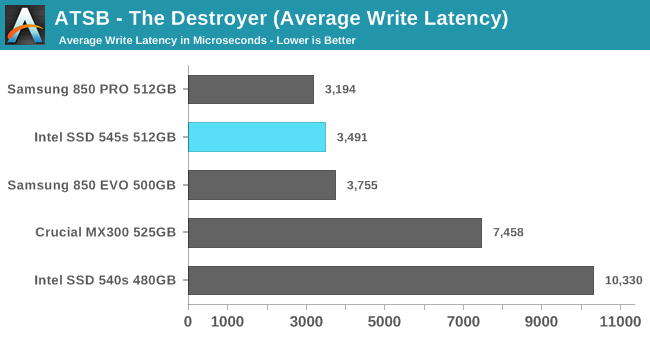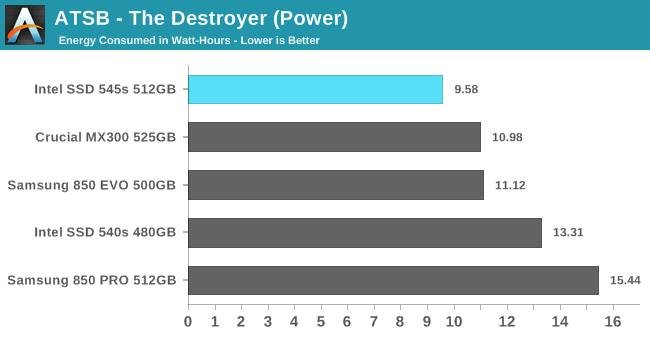The Intel SSD 545s (512GB) Review: 64-Layer 3D TLC NAND Hits Retail
by Billy Tallis on June 27, 2017 6:00 AM ESTAnandTech Storage Bench - The Destroyer
The Destroyer is an extremely long test replicating the access patterns of very IO-intensive desktop usage. A detailed breakdown can be found in this article. Like real-world usage, the drives do get the occasional break that allows for some background garbage collection and flushing caches, but those idle times are limited to 25ms so that it doesn't take all week to run the test. These AnandTech Storage Bench (ATSB) tests do not involve running the actual applications that generated the workloads, so the scores are relatively insensitive to changes in CPU performance and RAM from our new testbed, but the jump to a newer version of Windows and the newer storage drivers can have an impact.
We quantify performance on this test by reporting the drive's average data throughput, the average latency of the I/O operations, and the total energy used by the drive over the course of the test.

The Intel SSD 545s performs surprisingly well on The Destroyer, with an average data rate that surpasses the Samsung 850 EVO and potentially makes the 545s the new fastest SATA SSD with 3D NAND. The 3D MLC-based Samsung 850 PRO is still out of reach, but the 545s is a big improvement over the 540s and the Crucial MX300.

The Intel 545s also ranks between the Samsung 850 PRO and 850 EVO in terms of average latency, with slightly more than half the latency of the Crucial MX300 and an even wider margin over the Intel 540s.


Separating the latency according to reads and writes, we see that the 545s is much closer to the Samsung 850 PRO than the 850 EVO for reads. The write latencies of the Samsung drives and the 545s are all much lower than the Crucial MX300 or Intel 540s.

In addition to delivering great performance for a SATA TLC SSD, the Intel 545s brings a huge improvement in power efficiency. The 545s uses 12% less energy than the Crucial MX300 or Samsung 850 EVO over the course of the test. Only a few SSDs have ever completed The Destroyer on such a small energy budget, and only one other TLC SSD has been this efficient.










74 Comments
View All Comments
t.s - Tuesday, June 27, 2017 - link
But of course, "If you want to play it safe", you could always go for the intel 545s /sDanNeely - Tuesday, June 27, 2017 - link
What happened to the performance consistency testing?Ryan Smith - Tuesday, June 27, 2017 - link
It's coming. But we had a rather short period of time to work on this."This launch comes at a bit of an awkward time for us. I've retired our aging 2015 SSD testbed and moved all the custom and homemade power measurement equipment over to a new system. Windows 8.1 is out and Windows 10 is in, and our IOmeter synthetic benchmarks are being replaced with Linux-based FIO tests that are more suited to modern TLC SSDs with SLC caches. For the past few weeks I've been focusing my efforts on validating the new testbed and test suite against NVMe SSDs, so the arrival at short notice of a new SATA SSD left me with no relevant comparison data."
Billy Tallis - Tuesday, June 27, 2017 - link
I didn't have time. I'll be doing it later this week. The new 2017 performance consistency test will be more thorough about testing different overprovisioning amounts, but that also makes it take longer to run.jjj - Tuesday, June 27, 2017 - link
The only interesting part is the rushed launch.Is anything much better about to hit the market or is Intel just trying to ship some more NAND in Q2 to "fix" the results? I suppose the Crucial BX300 is due in a couple of weeks, anything else?
Billy Tallis - Tuesday, June 27, 2017 - link
Intel wanted to beat WD and Toshiba to market with 64-layer 3D NAND. The Toshiba XG5 is already in the hands of OEMs but I'm not aware of any systems shipping with it yet. WD's 3D NAND SSDs are set to ship in Q3. They're all likely to have more powerful controllers than SM2259, and their charge trap flash cell architecture is closer to Samsung's V-NAND than IMFT 3D floating gate. Intel's right to want to be ahead of the others, but I think they could have spared another week.jjj - Tuesday, June 27, 2017 - link
Another week is no good, July 4th compromises the entire week.I was thinking more about value than perf when it comes to beating other new prods but chances are it is also about Q2 results, they want to boost the NAND segment a bit.
Do you have the Toshiba XG5 for review?
Billy Tallis - Tuesday, June 27, 2017 - link
Yes, the XG5 is what got bumped off the testbed to make room for these SATA drives. I'll be switching the testbed back to PCIe drives in a few days, after finishing up a few more tests on this batch of SATA drives.jjj - Tuesday, June 27, 2017 - link
Looking forward to that one.With the new tests, do you still look at mixed workloads?
Billy Tallis - Tuesday, June 27, 2017 - link
Yes. I'm not planning huge changes to the mixed workload tests, other than testing at 10% increments instead of 20%. My biggest goal with the new test suite is to have things more automated, which makes it easy to increase the level of detail in a lot of the tests (but it also makes it too easy to make the test suite take forever to run).